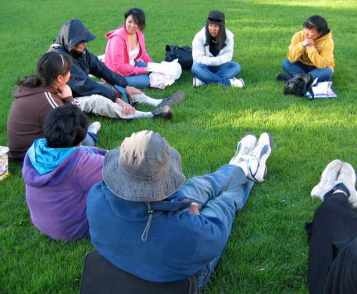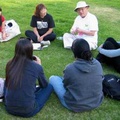Part 1 >>
However, the part of the Manzanar Pilgrimage that meant the most to me was the Manzanar at Dusk program that evening (held at Lone Pine High School in Lone Pine, California, about eight miles south of the Manzanar National Historic Site), because that was where we, members of the UCLA Nikkei Student Union, were able to actively participate. We tried to tell the stories of those who could not be there in person by presenting creative, historically accurate narratives of the Issei (first generation Japanese Americans; immigrants from Japan) and Nisei (second generation Japanese Americans, born in the United States, the children of the Issei). That was the project that I asked Auntie Pat to help me on. Manzanar at Dusk was our way of telling her story.

UCLA Nikkei Student Union member Katrina Kuraishi tells the story of Takeshita’s great aunt, Pat, at the 2011 Manzanar At Dusk program. (Photo: James To)
And that’s exactly what happened. One of my closest friends, Katrina Kuraishi, was chosen to read Auntie Pat’s narrative. I remember Katrina telling me that she was nervous about being the presenter, because she teared up every time she practiced it. Yet she was the perfect person for it.
As she read, I could hear Auntie Pat’s voice, not Katrina’s. I had to try my best to hold back the tears as she spoke about the time when her father came back to their family for the first time after being taken away for questioning. Katrina conveyed the same emotions that Auntie Pat did. It was as if Auntie Pat herself were standing up there, telling everyone about how amazing it was that her high school class was able to create a normal campus life, with sports, clubs, and even a yearbook. I felt like crying because I wished Auntie Pat could have sat next to me and listened to it in person. I felt like crying because I was so happy that her story could be heard.
The week after the Manzanar Pilgrimage, after Auntie Pat’s Poston III reunion, I called her. She had given my Grandma a collection of stories she wrote about her teenage camp life to pass on to me. I wanted to thank her for that, and for so much more.
“Auntie Pat? This is Jaymie,” I said, feeling a little bit nervous again for some reason.
“Oh, Jaymie! It’s so wonderful to hear your voice,” she replied, as expected.
She asked me if I had received her book, and said she had a wonderful time at the reunion because she got to see all of her friends. Then she asked me about the Pilgrimage.
“It was really good,” I started. “But, you know, remember how you helped me on a project last week?”
“Yes, did it go okay,” she asked. “Do you need more information for it?”
“No, no, it went great,” I replied. “But actually, it was for the Manzanar Pilgrimage.”
“Oh really?!” she said, excitedly.
“Yeah. I took all of the stories you told me last week, and sorta…reorganized them into one long story,” I explained, excitedly. “And then one of my friends read it at the Manzanar At Dusk program.”
“Oh-my-goodness!” she exclaimed, happily.
As Auntie Pat thanked me over and over again, telling me how important it was for the young people to listen, I couldn’t help but remember what Auntie Pat had told me last time I talked to her on the phone. She had sounded sad when she explained how her and her parent’s generation are referred to as the “Silent Generation.”
“I know that,” she said. “But I don’t want to be a forgotten generation. My story is part of my country’s history…it should be told. Everyone has a story to tell.”
Everyone has a story to tell, but not everyone has the chance to tell their story. Storytelling is more difficult than it seems. Remembering is not only enjoyable and nostalgic, but also painful and difficult. Listening is entertaining, but sometimes we hear things we might not have wanted to know. To be able to get a chance to tell a story, or even just ask to listen to a story, sometimes we need a little bit of help, a little push. I will forever be grateful to the 42nd Annual Manzanar Pilgrimage for giving me the push I needed to ask, and the chance for Auntie Pat’s story to be heard.

Takeshita (wearing pink sweatshirt) facilitates a small group discussion at the 2011 Manzanar At Dusk program on April 30, 2011. (Photo: Gann Matsuda)
*This was originally published on the Official Blog of the Manzanar Committee on July 24, 2011.
© 2011 Jaymie Takeshita




